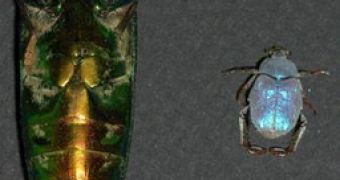Some beetles have really bright colors, but in the case of some species, it is hard to say which is their color. The metallic woodboring beetle Chrysochroa vittata seems to be red if watched head-on, while from its side, the beetle gets a greenish hue, completely green at an 80-degree angle.
Now, beetles' iridescence has inspired a team at the University of Namur, in Belgium, to develop synthetic iridescent materials mimicking their structure, as described in the research published in the "New Journal of Physics." The colors displayed by the new material can be predicted, and the structure can be manipulated for certain colors, resulting a large array of iridescent materials.
"In the context of iridescent materials, the greatest significance of our study is probably the fact that we are discovering new iridescent photonic structures in nature which give us inspiration to synthesize artificial materials whose (nano-) structures are presently out of reach of the human imagination," lead author Olivier Deparis told PhysOrg.com.
The research was made on Chrysochroa vittata and Hoplia coerulea. Beetles have a cuticle with layers of different thicknesses, acting differently on the light. What you see is the combination of the light reflected by different surfaces. At different angles, the reflectance changes to various wavelengths (H. coerulea goes from blue head-on, to violet).
In all iridescent insects, chitin is the culprit (in the shell of the mollusks, other chemicals are involved for creating iridescence). Chitin layers combine with air or water in specific ways, so that two species cannot have the same colors.
Beetles' nanometer-scale layers were used as templates by the research team to create iridescent surfaces out of titanium and silicon oxide layers. Two factors were connected to iridescent properties: the interval of the alternating layers, and the layer thickness ratio (how thicker one layer is, compared to another).
The period determines the dominant color (reflected wavelength) at head-on approach, while the layer thickness ratio gives "spectral richness" (how much the colors - wavelength - change when looked from different angles).
C. vittata has a layer period of around 200 nanometers (causing the red dominant color) and a small layer thickness ratio determining a large wavelength change of about 110 nanometers, as the incidence angle goes from 20 to 60 degrees. H. coerulea has a layer period of about 100 nanometers (causing the blue dominant color), while its layer thickness ratio is higher, resulting a relatively small wavelength change (around 20 nm) between 20 to 60 degrees.
"In the case of the present study, this [bio-inspired] approach is exemplified by the fact that we used two materials [titanium and silicon oxide] which were chosen among a large range of available oxides in order to generate very different iridescent aspects by taking advantage of the complexity. Here the complexity was introduced by considering the thicknesses of both layers as free and independent parameters, which is not usually the case in the design of standard multilayer Bragg reflectors," said Deparis.
A model was developed for predicting the reflectance spectrum of an iridescent material on each interference angle. By controlling the layer thicknesses, a large array of iridescent materials can be created, with applications in different industries on large-scale surfaces.
"Possible applications of iridescent materials are mainly in art (why not iridescent sculptures!), or architecture (glass or metal iridescent panels for decoration), painting (iridescent structural 'pigments' in the form of small particles in a solvent), ophtalmic glasses (here, coatings for which the color almost does not change with viewing angle may be interesting, similar to Hoplia coerula)," said Deparis.
.

 14 DAY TRIAL //
14 DAY TRIAL //